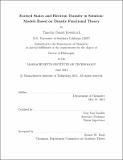| dc.contributor.advisor | Troy Van Voorhis. | en_US |
| dc.contributor.author | Kowalczyk, Timothy Daniel | en_US |
| dc.contributor.other | Massachusetts Institute of Technology. Dept. of Chemistry. | en_US |
| dc.date.accessioned | 2012-09-27T18:11:28Z | |
| dc.date.available | 2012-09-27T18:11:28Z | |
| dc.date.copyright | 2012 | en_US |
| dc.date.issued | 2012 | en_US |
| dc.identifier.uri | http://hdl.handle.net/1721.1/73432 | |
| dc.description | Thesis (Ph. D.)--Massachusetts Institute of Technology, Dept. of Chemistry, 2012. | en_US |
| dc.description | Cataloged from student-submitted PDF version of thesis. | en_US |
| dc.description | Includes bibliographical references (p. 161-185). | en_US |
| dc.description.abstract | Our understanding of organic materials for solar energy conversion stands to benefit greatly from accurate, computationally tractable electronic structure methods for excited states. Here we apply two approaches based on density functional theory (DFT) to predict excitation energies and electron transfer parameters in organic chromophores and semiconductors in solution. First, we apply constrained DFT to characterize charge recombination in a photoexcited donor-acceptor dyad and to understand the photophysical behavior of a fluorescent sensor for aqueous zinc. Second, we discover that the delta-self-consistent-field ([Delta]SCF) approach to excited states in DFT offers accuracy comparable to that of the better-established but more indirect linear-response time-dependent DFT approach, and we offer some justification for the similarity. Finally, we investigate a spin-restricted analog of [Delta]SCF known as restricted open-shell Kohn-Sham (ROKS) theory. We resolve a known ambiguity in the formal solution of the ROKS equations for the singlet excited state by presenting a self-consistent implementation of ROKS with respect to the mixing angle between the two open shells. The excited state methods developed and applied in this work contribute to the expanding toolkit of electronic structure theory for challenging problems in the characterization and design of organic materials. | en_US |
| dc.description.statementofresponsibility | by Timothy Daniel Kowalczyk. | en_US |
| dc.format.extent | 185 p. | en_US |
| dc.language.iso | eng | en_US |
| dc.publisher | Massachusetts Institute of Technology | en_US |
| dc.rights | M.I.T. theses are protected by
copyright. They may be viewed from this source for any purpose, but
reproduction or distribution in any format is prohibited without written
permission. See provided URL for inquiries about permission. | en_US |
| dc.rights.uri | http://dspace.mit.edu/handle/1721.1/7582 | en_US |
| dc.subject | Chemistry. | en_US |
| dc.title | Excited states and electron transfer in solution : models based on density functional theory | en_US |
| dc.type | Thesis | en_US |
| dc.description.degree | Ph.D. | en_US |
| dc.contributor.department | Massachusetts Institute of Technology. Department of Chemistry | |
| dc.identifier.oclc | 809562721 | en_US |
